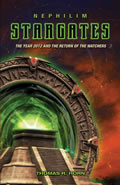PART 14
By Thomas R. Horn
October 24, 2010
NewsWithViews.com
THE HELL SCENARIO WILL BE NOTHING TO GRIN ABOUT
Synthetic biologists forecast that as computer code is written to create software to augment human capabilities, so too genetic code will be written to create life forms to augment civilization. —Jerome C. Glenn
Homo sapiens, the first truly free species, is about to decommission natural selection, the force that made us.... Soon we must look deep within ourselves and decide what we wish to become. —Edward Osborne Wilson
Resistance is futile! You will be assimilated! —the Borg
Not
long ago, a writer for Wired magazine named Elizabeth Svoboda contacted
me (Tom) to let me know she was writing an article about “research
advances using transgenic animals to  produce
pharmaceutical compounds.” She had come across an editorial by me
raising caution about this kind of experimentation and wondered if I might
be willing to provide points for her article, elaborating in areas where
I saw producing transgenic human-animals as potentially harmful. She stated
that most of the scientists she planned to quote were “pretty gung-ho
about the practice,” and said she thought it would be important
to provide some balance. I thanked her for the invitation and sent a short
summary of some, though not all, of the areas where concerns about this
science could be raised.
produce
pharmaceutical compounds.” She had come across an editorial by me
raising caution about this kind of experimentation and wondered if I might
be willing to provide points for her article, elaborating in areas where
I saw producing transgenic human-animals as potentially harmful. She stated
that most of the scientists she planned to quote were “pretty gung-ho
about the practice,” and said she thought it would be important
to provide some balance. I thanked her for the invitation and sent a short
summary of some, though not all, of the areas where concerns about this
science could be raised.
When the article was finally published by Wired, I was surprised that none of my notes had made it into the story. I contacted Elizabeth and asked why, and she replied that they had originally been included in her article, “Pharm Animals Crank Out Drugs,” but in order to create a positive spin on the story, the editors had censored my cautionary notes during the editing process. Elizabeth apologized and said she hoped the experience had not soured me on dealing with the magazine.
“It doesn’t sour me,” I assured her. “I just think the reporting by most agencies is lopsided and missing the opportunity to thoroughly engage such an important issue.” The fact was, Wired magazine deprived the public of balanced treatment on an important subject and concluded instead with a scientist by the name of Marie Cecile Van de Lavoir saying that potential human health benefits from transgenic research “justify tinkering” with nature’s plan. “If a transgenic animal produces a great cancer therapy,” she said, “I won’t hear anyone saying, ‘You shouldn’t do that.’” Van de Lavoir’s comments were undoubtedly in response to some of my observations before they were pulled, because in offering caution, I had specifically used the phrase “tinkering with nature’s plan.” Van de Lavoir’s short-sighted approach, like too many bioethicists engaged in the current debate, is as scary as the science, in our opinion. We wanted to contact her to suggest that she watch the film I Am Legend starring Will Smith, which opens appropriately enough with a scientist announcing the cure to cancer using a genetically engineered vaccine that blends animal and human genetics. If you’ve seen the film, you know the “cure” results in a human form of rabies that wipes out most life on earth—a real possibility, given the scenario.
Because any attempt at covering each potential Grin-tech, catastrophic, I-Am-Legend possibility in this book would be impractical, we summarize below a few of the most important areas in which conservatives, bioethicists, regulators, and especially Christians could become informed and involved in the public dialogue over the potential benefits and threats represented by these emerging fields of science:
GENETICALLY MODIFIED FOOD
Besides potential problems with transgenic animals, we have cited laboratory results in the past that were first reported by Dr. árpád Pusztai, repeat verified by scientist Irina Ermakova, and later substantiated by the International Journal of Biological Sciences that showed genetically modified (gm) food had surprisingly ill effects on the health of test rats, including the deterioration of every animal organ, atrophied livers, altered cells, testicular damage, altered sperm counts, shortened life spans, and cancer development. The laboratory findings led to the biotech industry suppressing the data and an eight-year court battle with monster corporations that did not want these results made public.
Over the last year, the silenced information has been in the news again as Greenpeace activists published evidence from the Russian trials verifying the ramifications of the negative health issues related to genetically modified foods. The wider ramifications from these and similar controlled experiments suggest that as current technology inserts pesticides, insect genes, animal dna, and other modified organisms directly into crops, the threat of hybrid viruses, prion contamination and new disease strains—which man can neither anticipate or prepare for—may arise. The prospects of this having an impact on mammalian health is almost certain to be a “when,” not “if,” concern, because, as Momma always said, “you are what you eat,” and the fact that the food you consumed this week most likely contained genetically modified ingredients is a current reality.
For example, a large portion of the soybean, corn, cottonseed, and canola in today’s human food supply and sold in most developed countries including the United States now has genes spliced in from foreign species—including bacteria and viruses—in its genetic makeup. These genetically modified organisms (gmos) have not only been linked to sickness, sterility, allergies, and even death among animals, but the Institute for Responsible Technology (irt) documents how the functioning genetically modified genes from these foods linger inside the human body, which could be future-catastrophic. “The only published human feeding experiment verified that genetic material inserted into gm soy transfers into the dna of intestinal bacteria and continues to function,” irt published. “This means that long after we stop eating gm foods, we may still have their gm proteins produced continuously inside us.”[1]
Among other things, irt says this means that: 1) If the antibiotic gene inserted into most gm crops were to transfer, it could create super diseases resistant to antibiotics; 2) If the gene that creates Bt toxin in gm corn were to transfer, it might turn our intestinal flora into living pesticide factories; and 3) Animal studies show that dna in food can travel into organs throughout the body, even into the fetus. Add to this the growing secrecy over the use of nanoparticles (eighty-four food-related uses are already on the market and in numerous consumer products such as sunscreens and cosmetics), which as a result of their size behave fundamentally different than other particles, and the possibility of health-related complications increases exponentially. Due to the large corporations (that stand to make billions of dollars from these products) having co-opted the fda into not requiring food labeling or package warnings on gmo foods and health products, you and I are now the biggest lab rats of all time in a “wait-and-see” experiment that will, feasibly within the decade, illustrate whether Pusztai and Ermakova’s rodent findings apply to us and our children.
SYNTHETIC BIOLOGY
Synthetic biology is one of the newest areas of biological research that seeks to design new forms of life and biological functions not found in nature. The concept began emerging in 1974, when Polish geneticist Waclaw Szybalski speculated about how scientists and engineers would soon enter “the synthetic biology phase of research in our field. We will then devise new control elements and add these new modules to the existing genomes or build up wholly new genomes. This would be a field with the unlimited expansion [of] building new...‘synthetic’ organisms, like a ‘new better mouse.’”[2] Following Szybalski’s speculation, the field of synthetic biology reached its first major milestone in 2010 with the announcement that researchers at the J. Craig Venter Institute (jcvi) had created an entirely new form of life nicknamed “Synthia” by inserting artificial genetic material, which had been chemically synthesized, into cells that were then able to grow. The jcvi Web site explains:
Genomic science has greatly enhanced our understanding of the biological world. It is enabling researchers to “read” the genetic code of organisms from all branches of life by sequencing the four letters that make up dna. Sequencing genomes has now become routine, giving rise to thousands of genomes in the public databases. In essence, scientists are digitizing biology by converting the A, C, T, and G’s of the chemical makeup of dna into 1’s and 0’s in a computer. But can one reverse the process and start with 1’s and 0’s in a computer to define the characteristics of a living cell? We set out to answer this question [and] now, this scientific team headed by Drs. Craig Venter, Hamilton Smith, and Clyde Hutchison have achieved the final step in their quest to create the first...synthetic genome [which] has been “booted up” in a cell to create the first cell controlled completely by a synthetic genome.[3]
The jcvi site goes on to explain how the ability to routinely write the software of life will usher in a new era in science, and with it, unnatural “living” products like Szybalski’s “new better mouse.” Better mice, dogs, horses, cows, or humans that grow from this science will be unlike any of the versions God made. In fact, researchers at the University of Copenhagen may look at what Venter has accomplished as amateur hour compared to their posthuman plans. They’re working on a third Peptide Nucleic Acid (pna) strand—a synthetic hybrid of protein and dna—to upgrade humanity’s two existing dna strands from double helix to triple. In so doing, these scientists “dream of synthesizing life that is utterly alien to this world—both to better understand the minimum components required for life (as part of the quest to uncover the essence of life and how life originated on earth) and, frankly, to see if they can do it. That is, they hope to put together a novel combination of molecules that can self-organize, metabolize (make use of an energy source), grow, reproduce and evolve.”[4] Our good friend Gary Stearman of Prophecy in the News and other biblical scholars are raising red flags over Synthia technology, warning that any biotech life application leading to modification of the human genotype for “improved” humans will be an inconceivable affront to God and could result in divine repercussions.
PATENTING NEW LIFE-FORMS
Questions are evolving now over “patenting” of transgenic seeds, animals, plants, and synthetic life-forms by large corporations, which at a minimum has already begun to impact the economy of rural workers and farmers through such products as Monsanto’s “terminator” seeds. Patenting of human genes will escalate these issues, as best-selling author Michael Crichton pointed out a while back in a piece for the New York Times titled, “Gene Patents Aren’t Benign and Never Will Be,” in which he claimed that people could die in the future from not being able to afford medical treatment as a result of medicines owned by patent holders of specific genes related to the genetic makeup of those persons. Former special counsel for President Richard Nixon, Charles Colson, added, “The patenting of genes and other human tissue has already begun to turn human nature into property. The misuse of genetic information will enable insurers and employers to exercise the ultimate form of discrimination. Meanwhile, advances in nanotechnology and cybernetics threaten to ‘enhance’ and one day perhaps rival or replace human nature itself—in what some thinkers are already calling ‘transhumanism.’”[5]
ANIMAL RIGHTS
Animal-rights activists have raised similar questions having to do with the ethics of altering animals in ways that could be demeaning to them—for instance, creating zombielike creatures that grow in feeder labs and gaze off into space from birth until death. Militarized animals that behave in unnatural, unpredictable ways. Humanized animals that become “self-aware,” or animals that produce human sperm and eggs, which then are used for in vitro fertilization to produce a human child. Who would the parents be? A pair of mice?
HUMAN CLONING
The prospect of human cloning was raised in the nineties immediately after the creation of the much-celebrated “Dolly,” a female domestic sheep clone. Dolly was the first mammal to be cloned using “somatic cell nuclear transfer,” which involves removing the dna from an unfertilized egg and replacing the nucleus of it with the dna that is to be cloned. Today, a version of this science is common practice in genetics engineering labs worldwide, where “therapeutic cloning” of human and human-animal embryos is employed for stem-cell harvesting (the stem cells, in turn, are used to generate virtually any type of specialized cell in the human body). This type of cloning was in the news during the writing of this book when it emerged from William J. Clinton Presidential Center documents that the newest member of the Supreme Court, Elena Kagan, had opposed during the Clinton White House any effort by Congress to prevent humans from being cloned specifically for experimental purposes, then killed. A second form of human cloning is called “reproductive cloning” and is the technology that could be used to create a person who is genetically identical with a current or previously existing human.
| Subscribe to the NewsWithViews Daily News Alerts! |
While Dolly was created by this type of cloning technology, the American Medical Association and the American Association for the Advancement of Science have raised caution on using this approach to create human clones, at least at this stage. Government bodies including the U.S. Congress have considered legislation to ban mature human cloning, and though a few states have implemented restrictions, contrary to public perception and except where institutions receive federal funding, no federal laws exist at this time in the United States to prohibit the cloning of humans. The United Nations, the European Union, and Australia likewise considered and failed to approve a comprehensive ban on human cloning technology, leaving the door open to perfect the science should society, government, or the military come to believe that duplicate or replacement humans hold intrinsic value.
I'll continue this list in the next entry than introduce the Heaven and Hell Scenarios mankind will soon face.
WATCH THE TRAILER! WARNING: NOT FOR THE WEAK!
[Editor's note: This series is based on research contained in Tom and Nita Horn's upcoming new book: Forbidden Gates: How Genetics, Robotics, Artificial Intelligence, Synthetic Biology, Nanotechnology, & Human Enhancement Herald the Dawn of Techno-Dimensional Spiritual Warfare.]
Sign up to be notified when the book on which this series is based is released and receive OVER $60.00 IN FREE GIFTS! Sign up here!
Click here for part -----> 1, 2, 3, 4, 5, 6, 7, 8, 9, 10, 11, 12, 13, 14,
Footnotes:
1,
Institute
for Responsible Technology.
2,
Waclaw Szybalski, In Vivo and in Vitro Initiation of Transcription, 405.
In A. Kohn and A. Shatkay (eds.), Control of Gene Expression, 23–24,
and Discussion 404–405 (Szybalski’s concept of Synthetic Biology),
411–412, 415–417 (New York: Plenum, 1974).
3,
“First
Self-Replicating Synthetic Bacterial Cell,” J. Craig Venter
Institute.
4,
Peter E. Nielsen, “Triple
Helix: Designing a New Molecule of Life,” Scientific American
(12/08).
5,
Charles W. Colson, Human Dignity in the Biotech Century (Downers Grove,
IL: InterVarsity, 2004) 8
� 2010 Thomas Horn - All Rights Reserved
Sign
Up For Free E-Mail Alerts
E-Mails are used strictly for
NWVs alerts, not for sale
Thomas Horn is the CEO of RaidersNewsNetwork.com and SurvivorMall.com.
Over the last decade, he has authored three books, wrote dozens of published editorials, and had several feature magazine articles. In addition to past articles at NewsWithViews.com , his works have been referred to by writers of the LA Times Syndicate, MSNBC, Christianity Today, Coast to Coast, World Net Daily, White House Correspondents and dozens of newsmagazines and press agencies around the globe. Tom's latest book is "The Ahriman Gate," which fictionalizes the use of biotechnology to resurrect Biblical Nephilim.
Thomas is also a well known radio personality who has guest-hosted and appeared on dozens of radio and television shows over the last 30 years, including "The 700 Club" and "Coast to Coast AM." When looking for a spokesperson to promote their film "Deceived" staring Louis Gossett Jr. and Judd Nelson, "Cloud 10 Pictures" selected Thomas as their spokesperson to explain the Christian viewpoint on UFO-related demonology.
Web Site: RaidersNewsNetwork.com
E-Mail: RaidersNewsUpdate@gmail.com












 Share
This Article
Share
This Article








